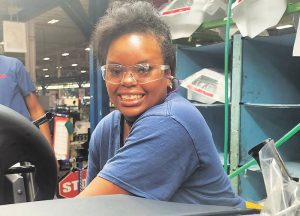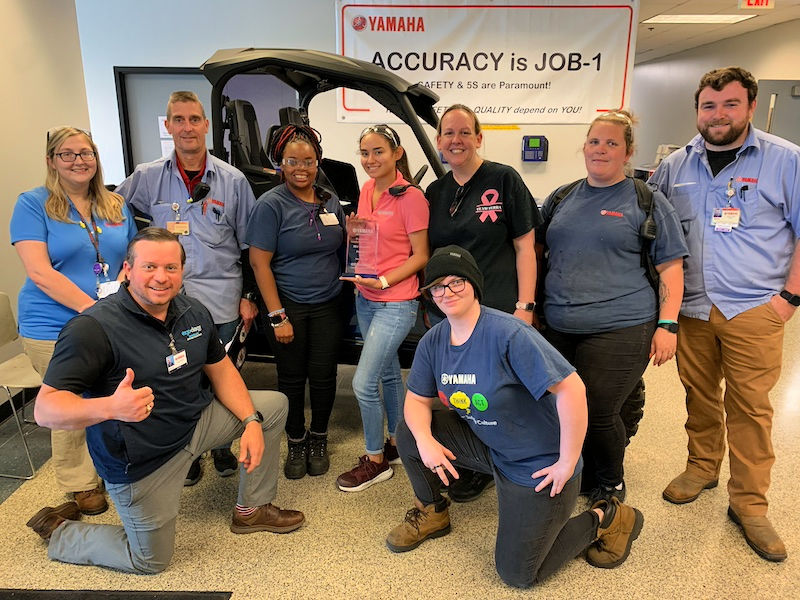SPONSORED FEATURE
Yamaha, a leading manufacturer of recreational vehicles and equipment in Newnan, Georgia, implemented a comprehensive ergonomics leadership program two years ago aimed at enhancing workplace safety and improving efficiency. For newly formed teams, in just several months the program will equip employees with valuable knowledge and techniques to prevent injuries and optimize their work processes.
The Importance of Ergo
One of the employees benefiting from this program is Hadiya (DeeDe) Harden, an R.O.V. assembly worker at Yamaha. Having been with the company for two and a half years, she is responsible for installing fenders on side-by-side vehicles. She highlights the importance of ergonomics in ensuring the well-being of employees and enhancing their productivity.
“Being in ergo is important because one minute I’m actually lifting things overhead, then I’m bending under the car to get things versus sitting in that chair and rolling under the car versus putting the fender on a higher ramp,” she said.
Ergonomics focuses on creating work environments that promote safety and efficiency by considering factors such as body mechanics, posture, and movement. Through the training that the program offers, Harden and her colleagues have learned how to assess risks associated with various tasks and implement measures to mitigate them.
Ergonomic training has provided Harden with a deeper understanding of the potential risks associated with repetitive tasks. By using ergonomic principles, such as proper lifting techniques and workstation setup, employees can avoid long-term health issues like back problems and minimize stress and fatigue caused by repetitive work.

The training has already made a significant impact on Harden’s work experience. She has been able to implement the techniques and measures learned, resulting in improved job performance and less physical stress.
“It did break down the aches and pains,” she said. “It really made the work environment better for me and others.”
Identifying Risks and Hazards Using Ergo Principles
“The ergo training is a development course for our associates at every level of the organization as it relates to ergonomics,” said Yamaha health and safety unit manager Brandon Smith. “We want to give them not only the language, but the ability to identify risks and hazards as it relates to ergonomics.”
Rather than just give a vague “this job is hard, it hurts” analysis, the goal is for associates to figure out why performing certain tasks might hurt and to empower them come up with solutions to improve their workplace.
“We look at our associates as subject matter experts on the work that they do,” said Smith. “No one can tell us how to do their jobs better than them.”
As issues like the potential for a sprain or a repetitive motion injury are identified, a percentage of risk is calculated and then steps are taken to reduce that risk. Cumbersome, physically demanding processes are examined from an engineering standpoint so that the process can be improved, and the physical strain reduced or eliminated.
“We are almost deputizing these individuals as safety experts within our facility as it relates to ergonomics,” said Smith. “We are putting them in a position where they cannot be hurt.”
Ergo Provides Leadership and Vision
Billy McGlamory, an engineer tech in the engineering department at Yamaha, has played a crucial role in facilitating the ergonomics training. With his 19 years of experience at the company, he brings a wealth of knowledge to the program. Billy’s background in welding and his passion for developing people have made him an invaluable asset in implementing ergonomic improvements across the company.
“As a supervisor, I’m all about developing people,” he said. “Yamaha is a firm believer in trying to build people in-house and promote them in house because you know exactly what you’ve got compared to bringing somebody up from outside, although they still do that.”
McGlamory emphasizes that the ergonomic training not only focuses on injury prevention but also aims to foster leadership skills among employees. By encouraging them to consider the well-being and productivity of their fellow workers, the training empowers employees to identify areas for improvement and take initiative in implementing changes.
“It gives them the tools and the vision to think outside the box – take care of your job and make your ergo better, then start looking at other people,” he said. “That’s one of the things DeeDe’s been doing.”
Ergo Develops Safety Culture
Yamaha Motor Manufacturing brought in Atlanta-based Ergo-ology, who customizes ergonomic programs for dozens of companies based on their individual needs to develop and implement their initiatives. Brock Anderson, the company’s CEO and principal consultant praised Yamaha’s level of participation.
“Right now, we have 68 companies that are doing this particular program, and Yamaha ranks in the top 10 percent as far as their true commitment to driving organizational changes and developing a formal process that can be sustainable for many years to come,” he said.
Yamaha plans to continue offering the ergonomics training program across the various business units at the facility. The company recognizes the value of investing in its employees and empowering them to create safer and more efficient work environments.
“When you are running a manufacturing facility as large as Yamaha, safety has to be your number one concern,” said Bob Brown, Vice President of Manufacturing. “Our people are our priority. That’s why we’ve implemented ergonomic training. If we can make our workplace safer, we’ve made it better.”
As Yamaha moves forward, the company envisions a workforce that is not only equipped with technical skills but also possesses the knowledge and mindset to identify and implement ergonomic improvements. By fostering a culture of continuous improvement and employee development, Yamaha aims to enhance its overall operations and maintain its commitment to safety and quality.
Yamaha’s implementation of ergonomic training underscores its dedication to the well-being of its employees and its commitment to creating a safer and more efficient workplace for everyone.
“I went almost three years without an accident in my shop,” said McGlamory. “And I explained to everybody, ‘I want you to go home the same way you came here. If you came with 10 fingers, I want you to go home with 10 fingers.’ You want everybody to understand safety is not anything to play with. Safety is going to be the number one thing with me because it affects their livelihood.”
Yamaha Motor Manufacturing Corporation of America designs and assembles WaveRunners, ATVs, Side by Sides, and Golf Cars at the Newnan plant. One of Coweta County’s largest private employers, Yamaha is currently seeking engineers and other professional team members. These full-time direct hires enjoy a comprehensive benefits package, including insurance, 401k, profit sharing, and more. Details are at yamahajobs.com.






